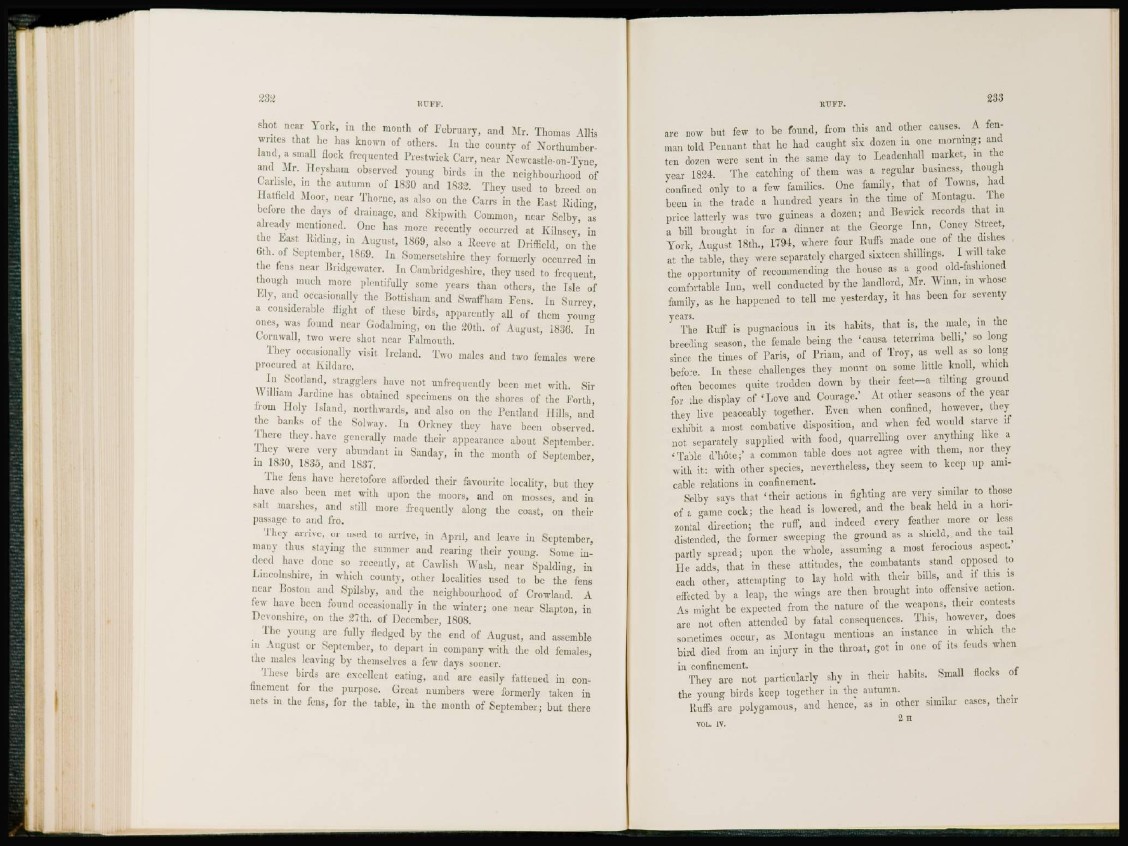
H U F F .
shot near York, in the month of February, anil Mr. Thomas ALUs
writes that he lias known of others. In the county of Northumberland,
a small flock frequented Prestwick Carr, near Ncwcasrlo-on-Tyne,
and Mr. 1 ley sham observed young birds in the neighbourhood of
Carlisle, in the autumn of 1830 and 1833. They used to breed on
Hatfield Moor, near Thorne, as also on the Carrs in the East Riding,
before the days of drainage, and Skipwith Common, near Selby, as
already mentioned. One has more recently occurred at Kilnsey, in
the East hiding, in August, 1809, also a Reeve at Driffield, on the
6th. of September, 1869. In Somersetshire they formerly occurred in
the fens near 11 ridge water. In Cambridgeshire, they used to frequent,
though much more plentifully some years than others, the Isle of
Ely, and occasionally the Bottisham and Swafl'liam Fens. In Surrey,
a considerable flight of these birds, apparently all of them young
ones, was found near Godalming, on the 20th. of August, 1836. In
Cornwall, two were shot near Falmouth.
They occasionally visit Ireland. Two males and two females were
procured at Kildare.
In Scotland, stragglers have not unfrequently been met with. Sir
William Jardinc has obtained specimens on the shores of the Forth,
from Holy Island, northwards, and also on the Pcntland Hills, and
the banks of the Sol way. In Orkney they have been observed.
There they. have generally made their appearance about September.
They were very abundant in San day, in the month of September,
in 1830, 1835, and 1837.
The fens have heretofore afforded their favourite locality, but they
have also been met with upon the moors, and on mosses, and in
salt marshes, and still more frequently along the coast, on their
passage to and fro.
They arrive, or used to arrive, in April, and leave in September,
many thus staying the summer and rearing their young. Some indeed
have done so recently, at Cawlish Wash, near Spalding, in
1 Lincolnshire, in which count)', other localities used to be the fens
near Boston and Spilsby, and the neighbourhood of Crowland. A
few have been found occasionally in the winter; one near Slapton, in
Devonshire, on the 27th. of December, 1808.
The young arc fully fledged by the end of August, and assemble
in August or September, to depart in company with the old females,
the males Leaving by themselves a few days sooner.
These birds are excellent eating, and are easily fattened in confinement
for the purpose. Great numbers were formerly taken in
nets in the fens, for the tabic, in the month of September; but there
RUFF.
are now but few to be found, from this and other causes. A fenman
told Pennant that he had caught six dozen in one morning; and
ten dozen were sent in the same day to Lcadeuhnll market, in the
year 1824. The catching of them was a regular business, though
confined only to a few families. One family, that of Towns, had
been in the trade a hundred years in the time of Montagu. The
price latterly was two guineas a dozen; and Bewick records that in
a bill brought in for a dinner at the George Inn, Coney Street,
York, August 18th., 1794, where four Huffs made one of the dishes
at the table, they were separately charged sixteen shillings. I will take
the opportunity of recommending the house as a good old-fashioned
comfortable Inn, well conducted by t h e landlord, Mr. M i n n , in whose
family, as he happened to tell me yesterday, it has been for seventy
years.
The Ruff is pugnacious in its habits, that is, the male, in the
breeding season, the female being the "causa teterrima belli,' so long
since the times of Paris, of Priam, and of Troy, as well as so long
before. In these challenges they mount on some little knoll, which
often becomes quite trodden down by their feet—a tilting ground
for the display of 'Love and Courage.' At other seasons of t h e year
they live peaceably together. Even when confined, however, they
exhibit a most combative disposition, and when fed would starve if
not separately supplied with food, quarrelling over anything like a
' T a b l e d'hote;' a common table does not agree with them, nor they
with i t : with other species, nevertheless, they seem to keep up amicable
relations in confinement.
Selby says that 'their actions in fighting arc very similar to those
of a game cock; the head is lowered, and the beak held in a horizontal
direction; the ruff, and indeed every feather more or less
distended, the former sweeping the ground as a shield, and the tail
partly spread; upon the whole, assuming a most ferocious aspect.*
He adds, that in these attitudes, the combatants stand opposed to
each other, attempting to lay hold with their bills, and if this is
effected by a leap, the wings are then brought into offensive action.
As might be expected from the nature of the weapons, their contests
are not often attended by fatal consequences. This, however, does
sometimes occur, as Montagu mentions an instance in which the
bird died from an injury in the throat, got in one of its feuds when
in confinement.
They are not particularly shy in their habits. Small flocks of
the young birds keep together in the autumn.
Ruffs arc polygamous, and hence, as in other similar cases, their